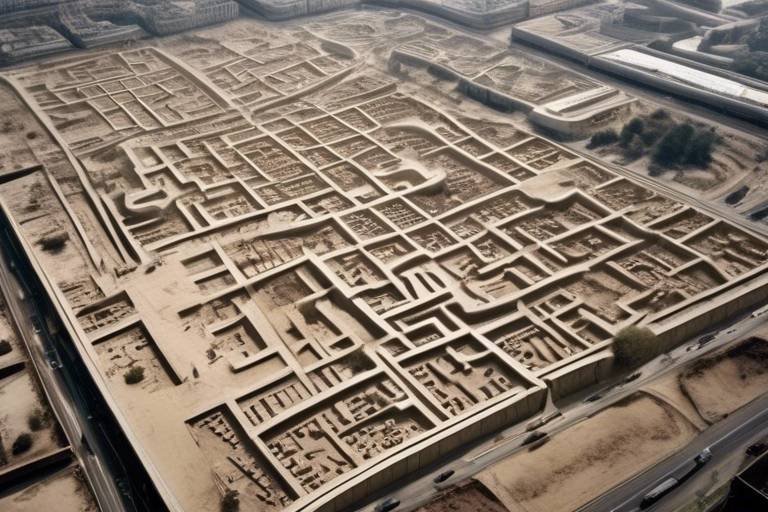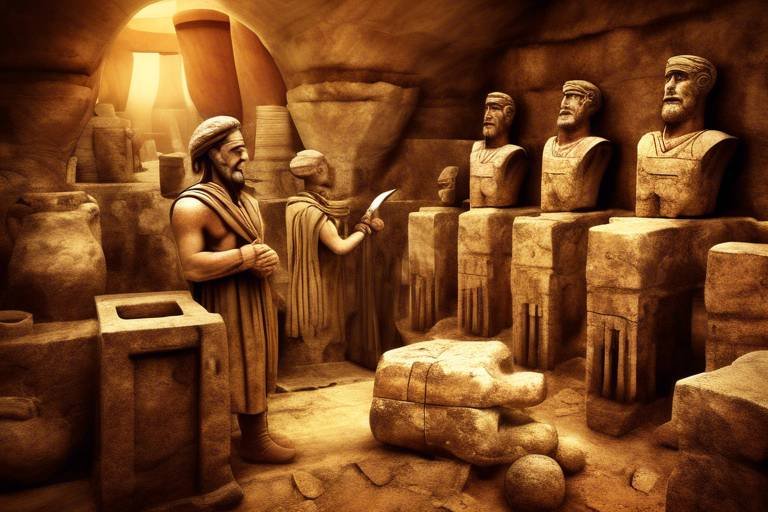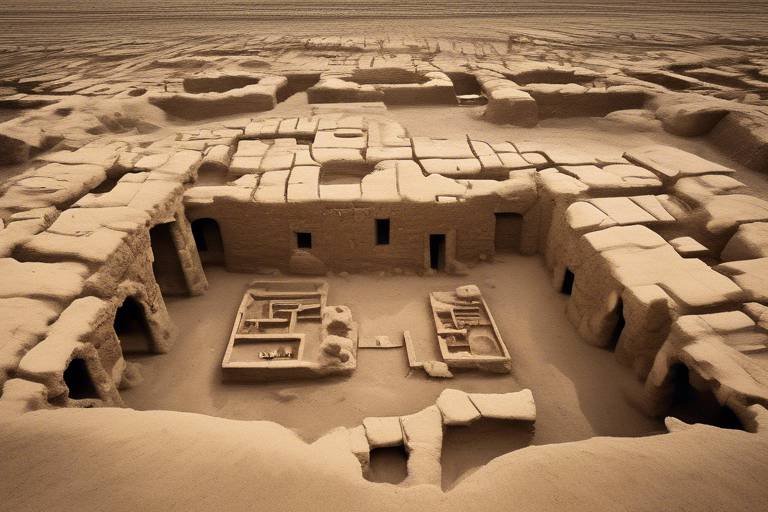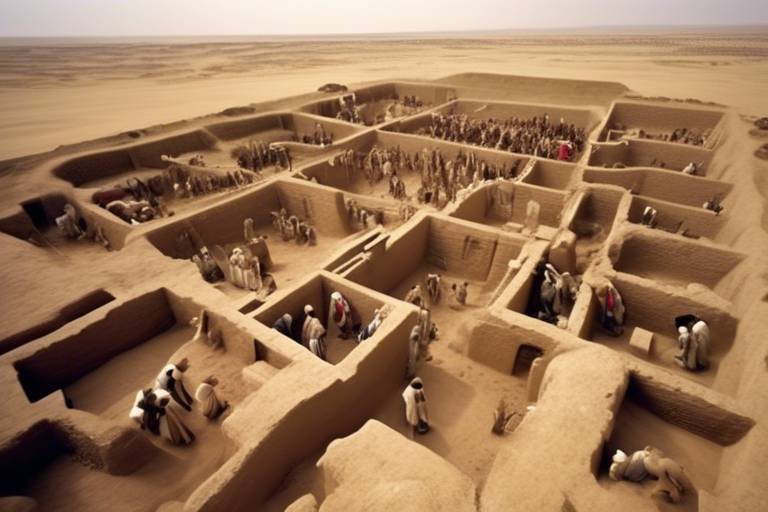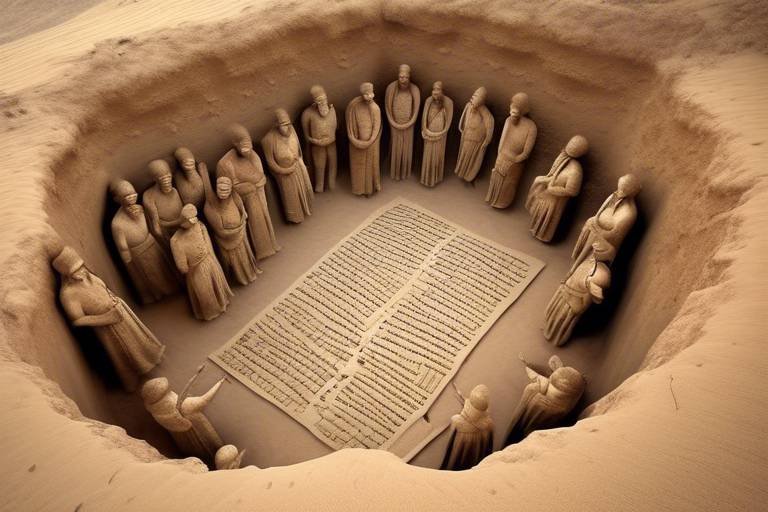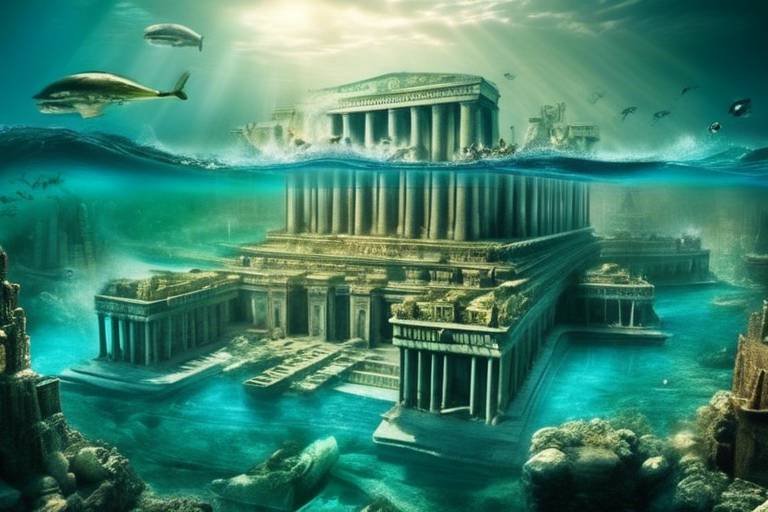Life and Death in the Ancient Aztec Society
Life and death in the ancient Aztec society were intertwined with intricate beliefs, rituals, and practices that shaped their cultural identity and societal norms. The Aztecs held a profound reverence for the cycle of life and death, viewing them as essential components of a cosmic order governed by powerful deities and spiritual forces.
Central to Aztec beliefs was the notion of an afterlife, where the souls of the deceased embarked on a journey to various realms guided by gods such as Mictlantecuhtli, the lord of the underworld. Human sacrifice was deemed crucial in ensuring a safe passage for the departed and maintaining harmony between the earthly realm and the divine.
The rituals performed by the Aztecs for the deceased were elaborate and multifaceted, encompassing funeral ceremonies, offerings to the gods, and burial traditions that reflected their spiritual worldview. These practices were not merely acts of remembrance but were seen as essential in honoring the departed and ensuring their well-being in the afterlife.
Aztec art vividly depicted the symbolism of death, with intricate representations of skeletal figures, underworld deities, and motifs symbolizing the cyclical nature of existence and rebirth. These artistic expressions served as visual narratives of the Aztec understanding of mortality and the transcendence of the soul beyond physical death.
Death permeated every aspect of Aztec society, influencing religious customs, cultural traditions, social hierarchies, and political structures. The Aztecs viewed death not as an end but as a transformative passage to the next stage of existence, where the deceased continued to play a vital role in the lives of the living through ancestral veneration and commemoration.
The legacy of Aztec death rituals endures in contemporary Mexican culture, manifesting in modern traditions of honoring the dead during Dia de los Muertos (Day of the Dead) celebrations. The profound influence of Aztec cosmology on Mexican society underscores the enduring significance of ancestral connections and the cyclical nature of life and death.

Aztec Beliefs on Life and Death
Life and death held profound significance in the ancient Aztec society, shaping their beliefs, rituals, and practices in profound ways. The Aztecs viewed life and death as interconnected aspects of a cyclical cosmic order, where death was not the end but a transition to another realm of existence. Central to their worldview was the belief in an afterlife, where the souls of the deceased embarked on a journey to different realms guided by various deities.
In Aztec beliefs, death was not a finality but a transformative process leading to the underworld, known as Mictlan, ruled by the god Mictlantecuhtli and his consort Mictecacihuatl. The Aztecs believed that the deceased needed to navigate through a series of challenges in the afterlife, requiring proper burial rites and offerings to ensure a safe passage and secure a favorable position in the realm of the dead.
The role of gods in Aztec beliefs about life and death was paramount, with deities such as Mictlantecuhtli, Quetzalcoatl, and Xolotl overseeing different aspects of the afterlife journey. Human sacrifice was a central element in Aztec religious practices, seen as a way to sustain the gods' strength and ensure the continuation of the cosmic cycle, where death and rebirth were intertwined.
Aztec art and iconography vividly portrayed the symbolism of death, featuring skeletal figures, underworld deities, and scenes depicting the cyclical nature of life and rebirth. These artistic representations served not only as aesthetic expressions but also as visual narratives of the Aztec worldview, emphasizing the interconnectedness of life, death, and the divine.
Death permeated various aspects of Aztec society, influencing social structures, political power dynamics, and cultural practices. The Aztecs' reverence for death manifested in elaborate funerary rituals, grandiose tombs, and commemorative monuments dedicated to honoring the deceased, reflecting a deep-seated respect for the cycle of life and the continuity of existence.
Exploring the Aztec views on the afterlife unveils a complex tapestry of beliefs, rituals, and traditions aimed at ensuring the soul's journey to its final destination. The Aztecs' intricate cosmology encompassed multiple realms of the afterlife, each governed by specific deities and requiring distinct rites to guide the departed souls through the perilous paths of the underworld.
The practice of human sacrifice, though controversial in modern perspectives, played a pivotal role in Aztec culture, serving as a sacred duty to maintain cosmic balance and honor the gods. The Aztecs believed that offering human life was essential to nourishing the divine forces that sustained the universe, highlighting the interconnectedness of life, death, and the spiritual realm.
Funerary practices in Aztec civilization varied widely, encompassing mummification, cremation, and burial customs tailored to individual social statuses and religious beliefs. The Aztecs' meticulous attention to honoring the dead through elaborate ceremonies and symbolic offerings underscored their profound respect for the cycle of life and the eternal bond between the living and the deceased.
The legacy of Aztec death rituals endures in contemporary Mexican culture, influencing modern traditions of ancestral veneration and commemoration. The echoes of Aztec cosmology resonate in cultural practices that pay homage to the interconnectedness of life and death, reminding us of the enduring significance of honoring the past and embracing the cyclical nature of existence.

Aztec Rituals for the Deceased
When delving into the intricate world of the ancient Aztec civilization, one cannot overlook the profound significance of rituals dedicated to the deceased. The Aztecs held elaborate ceremonies and practices to honor those who had passed on, deeply rooted in their spiritual beliefs and cultural traditions. These rituals were not mere formalities but rather intricate expressions of their worldview, reflecting a complex tapestry of beliefs surrounding life and death.
Central to Aztec rituals for the deceased were the funeral rites, meticulously designed to guide the soul of the departed through the perilous journey to the afterlife. Offerings to the gods played a crucial role in these ceremonies, symbolizing the Aztecs' reverence for the divine forces believed to govern the realms beyond the living. The act of burial itself was laden with symbolic meaning, representing a transition from the earthly plane to the spiritual realm, where the deceased would continue their existence in a different form.
Moreover, the Aztecs' burial traditions were marked by a deep connection to nature and the cyclical rhythms of life and death. The placement of grave goods and offerings in tombs reflected their belief in the continuity of existence beyond death, emphasizing the interconnectedness of all living beings in the cosmic order. Through these rituals, the Aztecs sought to maintain harmony between the physical and spiritual worlds, ensuring a smooth passage for the departed into the afterlife.
Symbolism permeated every aspect of Aztec rituals for the deceased, from the choice of offerings to the intricate iconography adorning burial sites. Images of gods associated with death and rebirth, such as Mictlantecuhtli and Mictecacihuatl, were prevalent in Aztec art, serving as reminders of the cycle of life and the impermanence of earthly existence. The intricate designs and motifs found in funerary objects and tombs were not merely decorative but imbued with profound spiritual significance, guiding the souls of the departed on their journey through the underworld.
Overall, the Aztec rituals for the deceased offer a glimpse into a civilization that viewed death not as an end but as a transformative passage to another realm. Through their elaborate ceremonies and symbolic practices, the Aztecs sought to honor the departed, maintain cosmic balance, and uphold their cultural heritage for generations to come.

Symbolism of Death in Aztec Art
In the vibrant tapestry of Aztec art, death held a prominent place, intricately woven into the fabric of their cultural expressions. The symbolism of death in Aztec art transcended mere mortality, delving into the realms of spirituality and cosmic significance. Central to Aztec beliefs was the notion of death as a transformative process, a passage from one state of being to another. This profound concept was vividly depicted in their artistic representations, where death was not feared but revered as an integral part of the cycle of life.
One of the most striking symbols of death in Aztec art was the portrayal of skeletal figures, often adorned with elaborate headdresses and jewelry. These skeletal figures, known as Mictlantecuhtli and Mictecacihuatl, represented the god and goddess of the underworld, embodying the dual nature of death as both fearsome and regenerative. The intricate details of these skeletal figures, with their sunken eye sockets and toothy grins, conveyed a sense of awe and reverence for the mysteries of the afterlife.
Furthermore, Aztec art abounded with imagery related to the cycle of life and rebirth, symbolized through motifs such as the calavera (skull) and the calacas (skeletons). These symbols served as reminders of the impermanence of earthly existence and the eternal cycle of death and renewal. Through their art, the Aztecs sought to capture the essence of mortality and transcendence, inviting viewers to contemplate the deeper meanings hidden beneath the surface.
The use of vibrant colors, intricate patterns, and symbolic motifs in Aztec art reflected a profound understanding of the interconnectedness of life and death. Each brushstroke, each carving, was imbued with layers of meaning, inviting viewers to ponder the mysteries of existence and the inevitability of mortality. In the intricate tapestries, stone carvings, and pottery of the Aztecs, death was not an end but a beginning, a portal to a realm of eternal significance.

Role of Death in Aztec Society
In the ancient Aztec society, death held a profound significance that permeated every aspect of life. It was not merely the end of one's existence but a transformative journey intertwined with religious beliefs and cultural practices. Death was viewed as a necessary part of the cosmic cycle, symbolizing both an end and a new beginning, much like the setting sun heralding the promise of a new dawn.
Death in Aztec society was intricately linked to their religious worldview, where the gods played a central role in determining the fate of the deceased. The Aztecs believed that various deities presided over different realms of the afterlife, guiding the souls of the departed on their journey towards eternal rest or reincarnation. This belief system instilled a sense of reverence and fear towards death, shaping the moral fabric of their society.
Moreover, the practice of human sacrifice was a defining feature of Aztec culture, serving as a means to honor the gods, ensure the continuity of the universe, and maintain order in the cosmos. The ritualistic offering of human life was believed to nourish the deities and sustain the delicate balance between the earthly realm and the divine, reinforcing the interconnectedness of life and death.
Death also wielded significant influence over social hierarchies and power structures within Aztec society. The nobility and elite classes often received grandiose funerary rites and elaborate tombs, reflecting their privileged status even in death. Conversely, commoners and warriors slain in battle were honored through simpler ceremonies, underscoring the inherent disparities in Aztec social stratification.
Furthermore, death served as a catalyst for communal cohesion and solidarity among the Aztecs. Funeral processions, mourning rituals, and ancestor veneration practices fostered a sense of collective identity and shared heritage, reinforcing the bonds that held their society together. The remembrance of the deceased through offerings and ceremonies ensured that their spirits remained a vital part of the community's ongoing narrative.
In essence, the role of death in Aztec society transcended mere mortality; it was a gateway to the divine, a testament to the cyclical nature of existence, and a cornerstone of cultural identity. By embracing death as an integral part of life, the Aztecs imbued their civilization with a profound sense of spirituality, reverence for the past, and a collective consciousness that resonates through the annals of history.

Aztec Views on the Afterlife
The Aztecs held intricate beliefs about the afterlife, viewing it as a multifaceted journey that the soul embarked upon after death. According to Aztec cosmology, the fate of the deceased was determined by various factors, including their actions in life and the rituals performed on their behalf. The afterlife was envisioned as a complex realm with different levels or layers, each corresponding to a specific destination based on the individual's conduct on Earth.
Central to Aztec views on the afterlife was the concept of duality, where the soul could face both rewards and punishments depending on its moral standing. The Aztecs believed in the existence of multiple afterlife destinations, such as Mictlan, the realm of the dead, and Tlalocan, the paradise reserved for those who died sacrificial deaths or in specific circumstances.
To ensure a safe passage for the departed soul, the Aztecs performed elaborate rituals and ceremonies, including offerings of food, incense, and precious items to appease the gods and guide the deceased on their journey. These rituals were considered crucial in facilitating the transition of the soul to its designated afterlife destination and securing the favor of the deities ruling over the realms of the dead.
Moreover, the Aztecs believed in the cyclical nature of life and death, viewing death not as an end but as a transformative phase in the eternal cycle of existence. Death was seen as a necessary part of the cosmic order, essential for the regeneration and renewal of life, symbolizing the continuous cycle of creation and destruction that governed the universe.
Through their beliefs and rituals surrounding the afterlife, the Aztecs sought to maintain harmony with the spiritual forces governing the cosmos and ensure the well-being of the deceased in the realms beyond. Their complex cosmology and profound reverence for death reflected a deep-seated understanding of the interconnectedness of life, death, and the supernatural realms.

Impact of Human Sacrifice on Aztec Culture
The impact of human sacrifice on Aztec culture was profound and multifaceted, shaping various aspects of their society and belief system. Human sacrifice played a central role in Aztec religious practices, serving as a means to appease the gods and maintain cosmic order. The Aztecs believed that offering human lives in rituals ensured the continued existence of the world and the prosperity of their civilization.
Moreover, human sacrifice had social implications in Aztec society, influencing power dynamics and social hierarchy. Those who were sacrificed were often considered honored individuals, chosen for their physical perfection or societal status. The act of sacrifice elevated their status even further, with some individuals willingly embracing their role as offerings to the gods.
From a cosmological perspective, human sacrifice was believed to sustain the universe and prevent cataclysmic events. The Aztecs viewed the shedding of human blood as a necessary exchange for the gods' favor and protection. Sacrificial rituals were intricately woven into the fabric of Aztec culture, permeating every aspect of life and death.

Funerary Practices in Aztec Civilization
Funerary practices in the ancient Aztec civilization were diverse and deeply intertwined with their religious beliefs and cultural traditions. The Aztecs held elaborate ceremonies to honor the deceased and ensure a safe passage to the afterlife. One of the common practices was mummification, where the bodies of the deceased were preserved through various methods to accompany them in the journey beyond life. Additionally, cremation was also a prevalent funerary practice among the Aztecs, symbolizing the transformation of the physical body into ashes, which were believed to release the soul into the spiritual realm.
Moreover, burial customs played a significant role in Aztec funerary practices. The Aztecs constructed intricate tombs and monuments to honor the dead, reflecting their reverence for ancestors and belief in the continuity of life beyond death. These burial sites were often adorned with offerings of food, jewelry, and other valuable items, signifying the importance of the deceased in the afterlife. The Aztecs believed that the spirits of the departed required these offerings to sustain them in the underworld and maintain a connection with the living.
Furthermore, the Aztecs practiced ritualistic ceremonies to commemorate the deceased, involving music, dance, and prayers to guide the souls of the departed on their journey. These ceremonies were conducted by priests and shamans, who played a crucial role in facilitating communication between the living and the dead. The Aztecs viewed death as a transformative process rather than an end, with the deceased transitioning into a new existence in the afterlife, where they continued to play a vital role in the cosmic order.

Legacy of Aztec Death Rituals
The legacy of Aztec death rituals continues to resonate in contemporary Mexican culture, serving as a profound reminder of the civilization's rich spiritual heritage and enduring influence. The intricate practices and beliefs surrounding death in Aztec society have left an indelible mark on modern traditions, shaping the way ancestral veneration is expressed and honored.
One of the key aspects of the legacy of Aztec death rituals is the profound respect and reverence shown towards ancestors. This deep-seated cultural value is reflected in various ceremonies and practices that pay homage to the deceased, emphasizing the importance of maintaining a connection with past generations and preserving familial ties across time.
Furthermore, the symbolic significance of death in Aztec cosmology continues to inspire artistic expression and cultural identity in Mexico. The imagery of skeletal figures, underworld gods, and themes of life and rebirth prevalent in Aztec art serve as a visual reminder of the cyclical nature of existence and the eternal journey of the soul.
Moreover, the legacy of Aztec death rituals extends beyond mere symbolism, influencing contemporary attitudes towards mortality, spirituality, and the afterlife. The enduring impact of Aztec beliefs on the interconnectedness of life and death is evident in the way modern Mexicans approach death with a blend of solemnity, celebration, and remembrance.
In conclusion, the legacy of Aztec death rituals serves as a testament to the profound cultural heritage of the ancient civilization, offering valuable insights into the complexities of human existence, the mysteries of the afterlife, and the enduring power of ancestral traditions.
Frequently Asked Questions
- What were the core beliefs of the Aztecs regarding life and death?
The Aztecs believed in a complex worldview that intertwined life and death. They viewed death as a necessary part of the cycle of life, leading to rebirth and renewal. Central to their beliefs was the idea that the afterlife held different realms for individuals based on their actions in life.
- How did the Aztecs honor the deceased through rituals and ceremonies?
The Aztecs performed elaborate ceremonies and rituals to honor the deceased, including funeral rites, offerings to gods, and burial traditions. These practices were essential to ensuring the safe passage of the soul to the afterlife and maintaining harmony between the living and the dead.
- What was the significance of human sacrifice in Aztec culture?
Human sacrifice played a crucial role in Aztec religious practices, serving as a means to appease the gods, maintain cosmic order, and ensure the continuity of life. While controversial, it was deeply intertwined with their beliefs about the afterlife and the interconnectedness of the spiritual and earthly realms.
- How have Aztec death rituals influenced modern Mexican culture?
The legacy of Aztec death rituals can be seen in contemporary Mexican culture through traditions like Dia de los Muertos (Day of the Dead), which honors deceased ancestors. The influence of Aztec cosmology on modern practices underscores the enduring impact of their beliefs on Mexican society.


